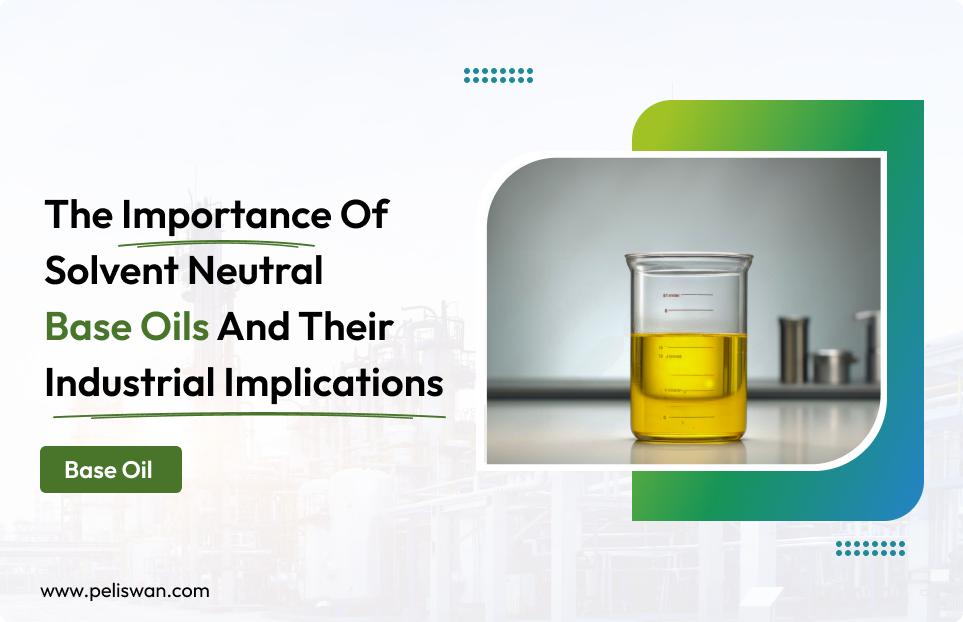
Jagat Jani
May 26, 2025
The Importance of Solvent Neutral Base Oils and Their Industrial Implications.
Base oils are classified into different types based on their source and refining process. Base oils are categorized as “N” (Neutral) and “SN” (Solvent Neutral) based on their refining process. “SN” base oils undergo solvent extraction, making them purer and higher in quality compared to “N” base oils, which are less refined and may contain more impurities.
- N (Neutral): These base oils undergo basic refining like distillation but lack solvent extraction, resulting in slightly higher impurities and a lower viscosity index.
- SN (Solvent Neutral): These oils go through additional solvent extraction, removing unwanted compounds like aromatics and sulfur, leading to improved stability and performance.
Base Oil SN 500
A mineral oil used as a lubricant in various industrial and automotive applications. Base oil SN 500 is a type of mineral oil that is commonly used as a lubricant in various industrial and automotive applications. It is a heavier grade than SN 150, with a higher viscosity and thicker consistency. SN 500 base oil is produced by the refining of crude oil through a process known as solvent refining, which involves the use of solvents to remove impurities and improve the oil’s properties.
Specifications:
- Kinematic Viscosity at 100°C: 10 – 12 cSt
- Viscosity Index: 89 – 92 cSt
- Flash Point: Minimum 230°C
- Pour Point: Maximum -6°C
- Density at 15°C: 0.905 – 0.915 g/cm³
- Density at 30°C: 0.885 – 0.890 g/cm³
- Aniline Point: 90 – 100°C
These properties make SN 500 suitable for formulating lubricants that require stable viscosity, good thermal stability, and low volatility.
Quality of Base Oil SN 500
The quality of Base Oil SN 500 is determined by its physical and chemical properties, which are specified by industry standards and regulations. Some of the key quality parameters for SN 500 base oil include:
- Viscosity: SN 500 base oil should have a kinematic viscosity between 16.3 and 21.8 centistokes (cSt) at 100°C, as measured by ASTM D445. This ensures that the oil has the appropriate thickness and lubricating properties for its intended application.
- Flash point: The flash point of SN 500 base oil should be at least 230°C, as measured by ASTM D92. This indicates the temperature at which the oil will ignite when exposed to a spark or flame, and is an important safety consideration.
- Pour point: SN 500 base oil should have a pour point no higher than -6°C, as measured by ASTM D97. This indicates the lowest temperature at which the oil will flow, and is important for applications where the oil may be exposed to low temperatures.
- Color: The color of SN 500 base oil should be no more than 2.5 on the ASTM D1500 color scale. This indicates the degree of discoloration or contamination in the oil, and can affect its appearance and ability to be used in certain applications.
- Chemical properties: SN 500 base oil should have low levels of impurities such as sulfur, carbon residue, and acidity. These properties can affect the oil’s stability, performance, and compatibility with other components in a lubricant formulation.
Usages of Base Oil SN 500
Base oil SN 500 is a versatile mineral oil that is used in a wide range of industrial and automotive applications. Some common uses of SN 500 base oil include:
- Hydraulic fluids: SN 500 base oil is used as a base fluid in hydraulic oils, which are used to power hydraulic systems in a range of industrial and mobile equipment.
- Gear oils: SN 500 base oil is used as a base fluid in gear oils, which are used to lubricate gears and other mechanical components in a range of equipment, including automotive transmissions, industrial gearboxes, and wind turbines.
- Transformer oils: SN 500 base oil is used as a base fluid in transformer oils, which are used to insulate and cool electrical transformers and other electrical equipment.
- Turbine oils: SN 500 base oil is used as a base fluid in turbine oils, which are used to lubricate steam and gas turbines in power generation and industrial applications.
- Compressor oils: SN 500 base oil is used as a base fluid in compressor oils, which are used to lubricate compressors in a range of industrial and automotive applications.
- Metalworking fluids: SN 500 base oil is used as a base fluid in metalworking fluids, which are used in machining and other metalworking processes to cool and lubricate cutting tools and workpieces.
Overall, SN 500 base oil is valued for its good lubricating properties, high viscosity index, and versatility, making it a popular choice for a wide range of lubricant formulations in various industries.
Base Oil SN 150
Base Oil SN 150 is a type of mineral oil that is commonly used in the formulation of lubricants and other industrial products. It is a low viscosity, high-quality base oil that is produced by refining crude oil. SN 150 is produced by solvent refining, which involves dissolving the crude oil in a solvent to remove impurities and other unwanted compounds.
Base Oil SN 150 is often used as a base oil in the formulation of automotive and industrial lubricants, hydraulic fluids, metalworking fluids, and other industrial products. Its low viscosity makes it ideal for use in applications that require a light-duty lubricant or a low-viscosity fluid.
Specifications:
- Density at 30°C: Approximately 0.870 g/cm³
- Kinematic Viscosity at 40°C : 24 to 28 cSt
- Kinematic Viscosity at 100°C: 5.0 – 5.5 cSt
- Viscosity Index: 90 – 92
- Flash Point : 200 – 210°C
- Pour Point : -3°C
Quality of Base Oil SN 150
Base Oil SN 150 is a high-quality base oil that meets certain industry standards for performance and purity. Some of the quality characteristics of Base Oil SN 150 include:
- Viscosity: SN 150 has a low viscosity, typically between 130 and 165 centistokes (cSt) at 40°C. This makes it suitable for use in low-viscosity lubricants and hydraulic fluids.
- Flash point: SN 150 has a high flash point, typically above 200°C. This means it has good thermal stability and is less likely to break down under high temperatures.
- Pour point: SN 150 has a low pour point, typically below -15°C. This means it can flow at low temperatures and is less likely to solidify or form deposits in cold environments.
- Oxidation stability: SN 150 has good oxidation stability, which means it resists the formation of sludge and other harmful by-products when exposed to air and high temperatures.
- Color: SN 150 is typically light in color, with a clear or pale yellow appearance.
Overall, Base Oil SN 150 is a high-quality base oil that is widely used in the lubricant and industrial fluids industry. Its low viscosity, high flash point, and good oxidation stability make it an ideal choice for a wide range of applications.
Usages of Base Oil SN 150
Base Oil SN 150 is a versatile base oil that is used in a wide range of industrial applications. Some of the common usages of Base Oil SN 150 include:
- Lubricants: Base Oil SN 150 is often used as a base oil in the formulation of automotive and industrial lubricants, including engine oils, gear oils, and compressor oils. Its low viscosity and good oxidation stability make it suitable for use in light-duty applications.
- Hydraulic fluids: Base Oil SN 150 is also used as a base oil in the formulation of hydraulic fluids, which are used to power machinery and equipment in various industries. Its low viscosity and good thermal stability make it ideal for use in hydraulic systems that operate under high pressures and temperatures.
- Metalworking fluids: Base Oil SN 150 is used in the formulation of metalworking fluids, which are used to cool and lubricate metalworking operations such as cutting, grinding, and machining. Its low viscosity and good wetting properties make it effective in reducing friction and heat during these operations.
- Industrial coatings: Base Oil SN 150 is also used as a carrier oil in the formulation of industrial coatings, such as paints, varnishes, and sealants. Its low viscosity and good solubility make it ideal for dissolving pigments and other additives.
Overall, Base Oil SN 150 is a high-quality base oil that is widely used in various industrial applications where low viscosity, good thermal stability, and good oxidation stability are required. Its versatility and compatibility with other additives make it a popular choice for formulators of lubricants, hydraulic fluids, metalworking fluids, and industrial coatings.
Conclusion:
SN 500 and SN 150 are both Group II mineral base oils derived from crude oil refining. While they share similar properties, they serve distinct applications based on their viscosity and performance characteristics. Both base oils play a critical role in lubricant formulations, ensuring optimal performance, wear protection, and efficiency in machinery and engines. The choice between SN 150 and SN 500 depends on the specific lubrication requirements, operating conditions, and viscosity needs of the intended application.


